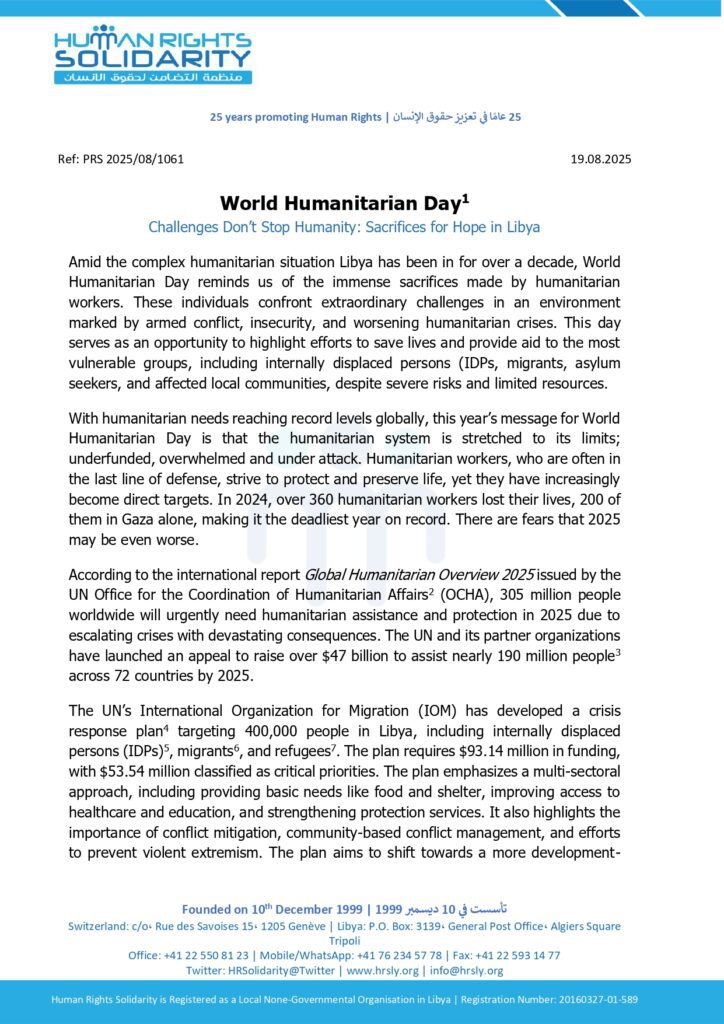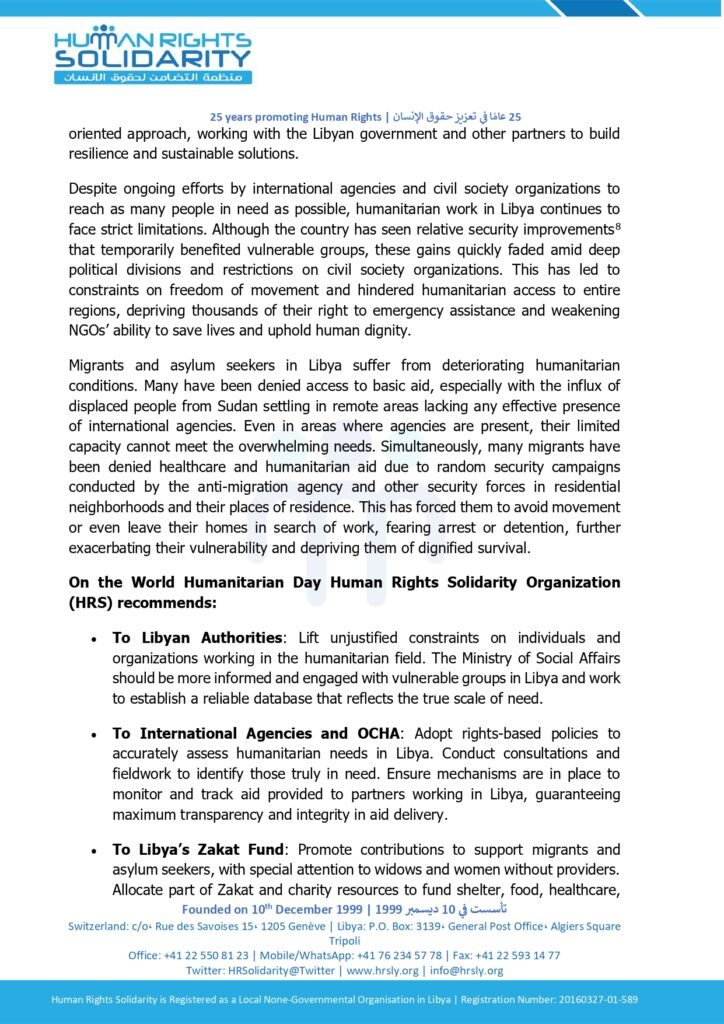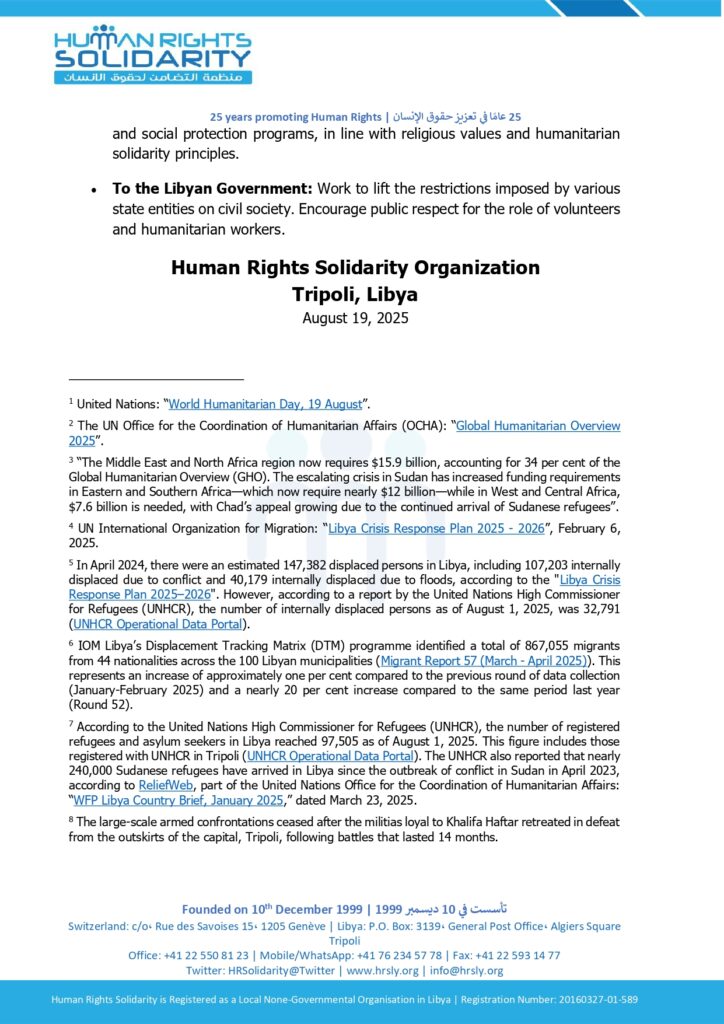World Humanitarian Day
| Ref: PRS 2025/08/1061 | 19.08.2025 |
World Humanitarian Day[i]
Challenges Don’t Stop Humanity: Sacrifices for Hope in Libya
Amid the complex humanitarian situation Libya has been in for over a decade, World Humanitarian Day reminds us of the immense sacrifices made by humanitarian workers. These individuals confront extraordinary challenges in an environment marked by armed conflict, insecurity, and worsening humanitarian crises. This day serves as an opportunity to highlight efforts to save lives and provide aid to the most vulnerable groups, including internally displaced persons (IDPs, migrants, asylum seekers, and affected local communities, despite severe risks and limited resources.
With humanitarian needs reaching record levels globally, this year’s message for World Humanitarian Day is that the humanitarian system is stretched to its limits; underfunded, overwhelmed and under attack. Humanitarian workers, who are often in the last line of defense, strive to protect and preserve life, yet they have increasingly become direct targets. In 2024, over 360 humanitarian workers lost their lives, 200 of them in Gaza alone, making it the deadliest year on record. There are fears that 2025 may be even worse.
According to the international report Global Humanitarian Overview 2025 issued by the UN Office for the Coordination of Humanitarian Affairs[ii] (OCHA), 305 million people worldwide will urgently need humanitarian assistance and protection in 2025 due to escalating crises with devastating consequences. The UN and its partner organizations have launched an appeal to raise over $47 billion to assist nearly 190 million people[iii] across 72 countries by 2025.
The UN’s International Organization for Migration (IOM) has developed a crisis response plan[iv] targeting 400,000 people in Libya, including internally displaced persons (IDPs)[v], migrants[vi], and refugees[vii]. The plan requires $93.14 million in funding, with $53.54 million classified as critical priorities. The plan emphasizes a multi-sectoral approach, including providing basic needs like food and shelter, improving access to healthcare and education, and strengthening protection services. It also highlights the importance of conflict mitigation, community-based conflict management, and efforts to prevent violent extremism. The plan aims to shift towards a more development-oriented approach, working with the Libyan government and other partners to build resilience and sustainable solutions.
Despite ongoing efforts by international agencies and civil society organizations to reach as many people in need as possible, humanitarian work in Libya continues to face strict limitations. Although the country has seen relative security improvements[viii] that temporarily benefited vulnerable groups, these gains quickly faded amid deep political divisions and restrictions on civil society organizations. This has led to constraints on freedom of movement and hindered humanitarian access to entire regions, depriving thousands of their right to emergency assistance and weakening NGOs’ ability to save lives and uphold human dignity.
Migrants and asylum seekers in Libya suffer from deteriorating humanitarian conditions. Many have been denied access to basic aid, especially with the influx of displaced people from Sudan settling in remote areas lacking any effective presence of international agencies. Even in areas where agencies are present, their limited capacity cannot meet the overwhelming needs. Simultaneously, many migrants have been denied healthcare and humanitarian aid due to random security campaigns conducted by the anti-migration agency and other security forces in residential neighborhoods and their places of residence. This has forced them to avoid movement or even leave their homes in search of work, fearing arrest or detention, further exacerbating their vulnerability and depriving them of dignified survival.
On the World Humanitarian Day Human Rights Solidarity Organization (HRS) recommends:
- To Libyan Authorities: Lift unjustified constraints on individuals and organizations working in the humanitarian field. The Ministry of Social Affairs should be more informed and engaged with vulnerable groups in Libya and work to establish a reliable database that reflects the true scale of need.
- To International Agencies and OCHA: Adopt rights-based policies to accurately assess humanitarian needs in Libya. Conduct consultations and fieldwork to identify those truly in need. Ensure mechanisms are in place to monitor and track aid provided to partners working in Libya, guaranteeing maximum transparency and integrity in aid delivery.
- To Libya’s Zakat Fund: Promote contributions to support migrants and asylum seekers, with special attention to widows and women without providers. Allocate part of Zakat and charity resources to fund shelter, food, healthcare, and social protection programs, in line with religious values and humanitarian solidarity principles.
- To the Libyan Government: Work to lift the restrictions imposed by various state entities on civil society. Encourage public respect for the role of volunteers and humanitarian workers.
Human Rights Solidarity Organization
Tripoli, Libya
August 19, 2025
[i] United Nations: “World Humanitarian Day, 19 August”.
[ii] The UN Office for the Coordination of Humanitarian Affairs (OCHA): “Global Humanitarian Overview 2025”.
[iii] “The Middle East and North Africa region now requires $15.9 billion, accounting for 34 per cent of the Global Humanitarian Overview (GHO). The escalating crisis in Sudan has increased funding requirements in Eastern and Southern Africa—which now require nearly $12 billion—while in West and Central Africa, $7.6 billion is needed, with Chad’s appeal growing due to the continued arrival of Sudanese refugees”.
[iv] UN International Organization for Migration: “Libya Crisis Response Plan 2025 – 2026”, February 6, 2025.
[v] In April 2024, there were an estimated 147,382 displaced persons in Libya, including 107,203 internally displaced due to conflict and 40,179 internally displaced due to floods, according to the “Libya Crisis Response Plan 2025–2026“. However, according to a report by the United Nations High Commissioner for Refugees (UNHCR), the number of internally displaced persons as of August 1, 2025, was 32,791 (UNHCR Operational Data Portal).
[vi] IOM Libya’s Displacement Tracking Matrix (DTM) programme identified a total of 867,055 migrants from 44 nationalities across the 100 Libyan municipalities (Migrant Report 57 (March – April 2025)). This represents an increase of approximately one per cent compared to the previous round of data collection (January-February 2025) and a nearly 20 per cent increase compared to the same period last year (Round 52).
[vii] According to the United Nations High Commissioner for Refugees (UNHCR), the number of registered refugees and asylum seekers in Libya reached 97,505 as of August 1, 2025. This figure includes those registered with UNHCR in Tripoli (UNHCR Operational Data Portal). The UNHCR also reported that nearly 240,000 Sudanese refugees have arrived in Libya since the outbreak of conflict in Sudan in April 2023, according to ReliefWeb, part of the United Nations Office for the Coordination of Humanitarian Affairs: “WFP Libya Country Brief, January 2025,” dated March 23, 2025.
[viii] The large-scale armed confrontations ceased after the militias loyal to Khalifa Haftar retreated in defeat from the outskirts of the capital, Tripoli, following battles that lasted 14 months.




